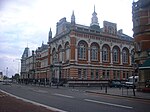St Mary's Church, Leyton
Church of England church buildings in the London Borough of Waltham ForestGrade II* listed churches in LondonLeyton

The Parish Church of St Mary with St Edward and St Luke, Leyton, also known as Leyton Parish Church and formerly, St Mary the Virgin, Leyton, is a Church of England parish church in Leyton, East London. Although records of the church go back to about 1200, it has been repeatedly rebuilt; the oldest surviving fabric dates to 1658, but a majority of it is from the early 19th century. It is a Grade II* listed building.
Excerpt from the Wikipedia article St Mary's Church, Leyton (License: CC BY-SA 3.0, Authors, Images).St Mary's Church, Leyton
Church Road, London Leyton (London Borough of Waltham Forest)
Geographical coordinates (GPS) Address Nearby Places Show on map
Geographical coordinates (GPS)
| Latitude | Longitude |
|---|---|
| N 51.563511 ° | E -0.014354 ° |
Address
Church Road
Church Road
E10 5JP London, Leyton (London Borough of Waltham Forest)
England, United Kingdom
Open on Google Maps







